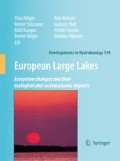Abstract
Since the middle of 1990s the trend of Lake Balaton towards an increasingly trophic status has been reversed, but N2-fixing cyanobacteria are occasionally dominant, endangering water quality in summer. The sources of nitrogen and its uptake by growing phytoplankton were therefore studied. Experiments were carried out on samples collected from the middle of the Eastern (Siófok) and Western (Keszthely) basins between February and October 2001. Ammonium, urea and nitrate uptake and ammonium regeneration were measured in the upper 5-cm layer of sediment using the 15N-technique. Ammonium was determined by an improved microdiffusion assay. N2 fixation rates were measured by the acetylene-reduction method. Ammonium regeneration rates in the sediment were similar in the two basins. They were relatively low in winter (0.13 and 0.16 µg N cm−3 day−1 in the Eastern and Western basin, respectively), increased slowly in the spring (0.38 and 0.45 µg N cm−3 day−1) and peaked in late summer (0.82 and 1.29 µg N cm−3 day−1, respectively). Ammonium uptake was predominant in spring in the Eastern basin and in summer in the Western basin, coincident with the cyanobacterial bloom. The amount of N2 fixed was less than one third of the internal load during summer when external N loading was insignificant. Potentially, the phytoplankton N demand could be supported entirely by the internal N load via ammonium regeneration in the water column and sediment. However, the quantity of N from ammonium regeneration in the upper layer of sediment combined with that from the water column would limit the standing phytoplankton crop in spring in both basins and in late summer in the Western basin, especially when the algal biomass increases suddenly.
Access this chapter
Tax calculation will be finalised at checkout
Purchases are for personal use only
Preview
Unable to display preview. Download preview PDF.
References
Blomqvist, P., A. Peterson & P. Hyenstrand, 1994. Ammonium nitrogen: A key regulatory factor causing dominance of non-nitrogen-fixing cyanobacteria in aquatic systems. Archiv für Hydrobiologie 132: 141–164.
Bowden, W. B., 1984. A nitrogen-15 isotope dilution study of ammonium production and consumption in a marsh sediment. Limnology and Oceanography 29: 1004–1015.
Brooks, P. D., J. M. Stark, B. B. McInteer & T. Preston, 1989. Diffusion method to prepare soil extracts for automated nitrogen-15 analysis. Soil Science Society of America Journal 53: 1707–1711.
Cochlan, W. P. & P. J. Harrison, 1991. Kinetics of nitrogen (nitrate, ammonium and urea) uptake by the picoflagellate Micromonas pusilla (Prasinophyceae). Journal of Experimental Marine Biology and Ecology 153: 129–141.
Glibert, P. M., C. Garside, J. A. Fuhrman & M. R. Roman, 1991. Time-dependent coupling of inorganic and organic nitrogen uptake and regeneration in the plume of the Chesapeake Bay estuary and its regulation by large heterotrophs. Limnology and Oceanography 36: 895–909.
Herodek, S., 1986. Phytoplankton changes during eutrophication and P and N metabolism. In Somlyódy, L. & G. van Straten (eds), Modeling and Managing Shallow Lake Eutrophication. Springer Verlag, Berlin, 183–204.
Lomas, M. W., P. M. Glibert, G. M. Berg & M. Burford, 1996. Characterization of nitrogen uptake by natural populations of Aureococcus anophagefferens (Chrysophyceae) as a function of incubation duration, substrate concentration, light and temperature. Journal of Phycology: 32: 907–916.
Mitamura, O., Y. Saijo, K. Hino & F. A. R. Barbosa, 1995. The significance of regenerated nitrogen for phytoplankton productivity in the Rio Doce Valley Lakes, Brazil. Archiv für Hydrobiologie 134: 179–194.
Németh, J. & L. Vörös, 1986. Koncepció és módszertan felszíni vizek algológiai monitoringjához. OKTH, Budapest, 135 pp. (in Hungarian).
Présing, M., S. Herodek, T. Preston & L. Vörös, 2001a. Nitrogen uptake and the importance of internal nitrogen loading in Lake Balaton. Freshwater Biology 46: 125–139.
Présing, M., T. Preston, A. Kovács & P. Sprőber, 2001b. Internal and external nitrogen supply of phytoplankton in Lake Balaton (Hungary). Biwako 2001, 9th International Conference on the Conservation and Management of Lakes, Kyoto, Japan. Partnerships for Sustainable Life in Lake Environments, Conference Proceedings, Session 5: 272–275.
Slawyk, G. & P. Raimbault, 1995. Simple procedure for simultaneous recovery of dissolved inorganic and organic nitrogen in 15N-tracer experiments and improving the isotopic mass balance. Marine Ecology Progress Series 124: 289–299.
Somlyódy, L., S. Herodek, Cs. Aradi, A. Clement, Gy. Dévai, V. Istvánovics & Gy. Varga, 1997. Revision of the Lower Kis-Balaton Reservoir. Synthesis Report, Technical University, Budapest.
Takamura, N., T. Iwakuma & M. Yasuno, 1987. Uptake of 13Cand 15N (ammonium, nitrate and urea) by Microcystis in Lake Kasumigaura. Journal of Plankton Research 9: 151–165.
Utermöhl, H., 1958. Zur Vervollkommnung der quantitativen Phytoplankton-Methodik. Mitteilungen Internationale Vereinigung für Theoretische und Angewandte Limnologie 9: 1–38.
Vörös, L. & K. V.-Balogh, 1998. A Balaton Keszthelyimedencéjének szénforgalma. Hidrológiai Közlöny 78: 385–386 (in Hungarian).
Vörös, L., K. V.-Balogh & S. Herodek, 1996. Microbial food web in a large shallow lake (Lake Balaton, Hungary). Hydrobiologia 339: 57–65.
Author information
Authors and Affiliations
Corresponding author
Editor information
Editors and Affiliations
Rights and permissions
Copyright information
© 2007 Springer Science+Business Media B.V.
About this chapter
Cite this chapter
Présing, M. et al. (2007). Phytoplankton nitrogen demand and the significance of internal and external nitrogen sources in a large shallow lake (Lake Balaton, Hungary). In: Nõges, T., et al. European Large Lakes Ecosystem changes and their ecological and socioeconomic impacts. Developments in Hydrobiology, vol 199. Springer, Dordrecht. https://doi.org/10.1007/978-1-4020-8379-2_10
Download citation
DOI: https://doi.org/10.1007/978-1-4020-8379-2_10
Publisher Name: Springer, Dordrecht
Print ISBN: 978-1-4020-8378-5
Online ISBN: 978-1-4020-8379-2
eBook Packages: Biomedical and Life SciencesBiomedical and Life Sciences (R0)

